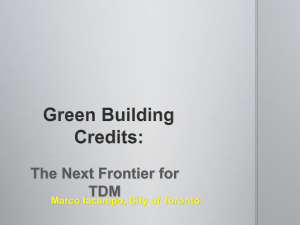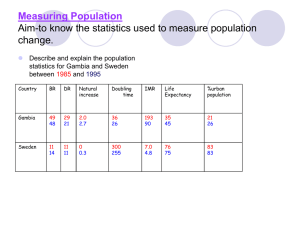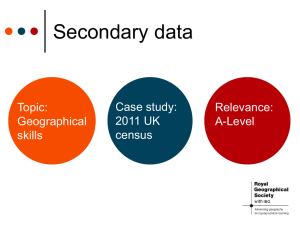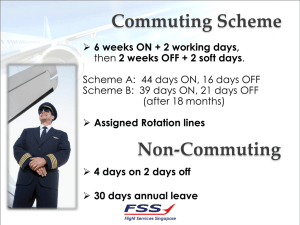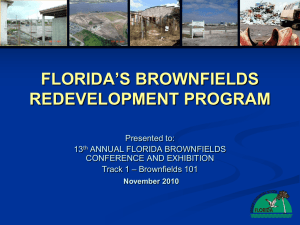PPT - Carnegie Mellon University
advertisement
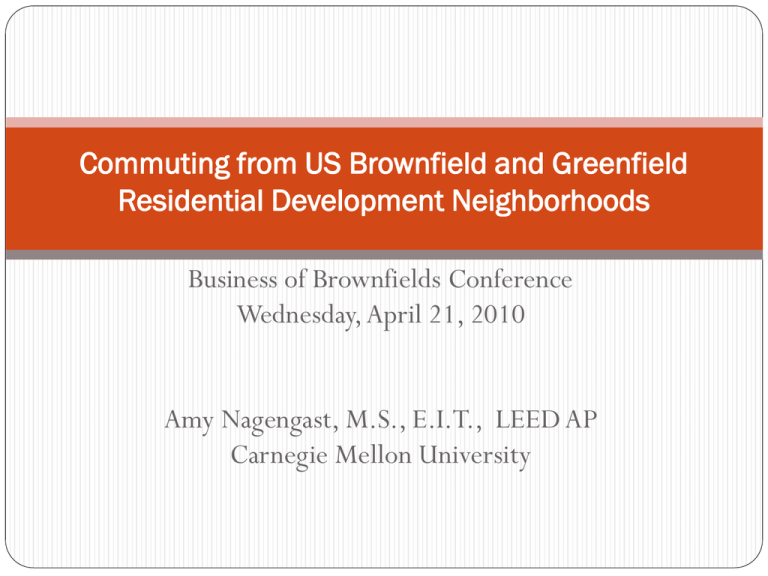
Commuting from US Brownfield and Greenfield Residential Development Neighborhoods Business of Brownfields Conference Wednesday, April 21, 2010 Amy Nagengast, M.S., E.I.T., LEED AP Carnegie Mellon University Introduction Data Methods Results Overview Project Overview Brief Intro to Life Cycle Assessment Research Data Sources Commuting Analysis Distance to City Center Transportation Modes Travel Time Energy Impacts Greenhouse Gas (GHG) Emissions Conclusions Brownfield Commuting and LEED Future Work 2 Conclusions Future Work Introduction Data Methods Results Future Work Conclusions Assessing Brownfield Sustainability: Life Cycle Analysis and Carbon Footprinting EPA Funded Project consisting of: 1. Training - working with network of Main Street and Elm Street Managers across PA 2. Technical Assistance - developing a multi-attribute decision-making tool to assist in prioritizing sites 3. Research- quantifying Brownfield and Greenfield Development life cycle environmental impacts >This study: Focus on Commuting Impacts (use phase) > Also conducting broader case studies 3 Introduction Data Methods Results Future Work Conclusions The “Elevator Pitch” to Life Cycle Assessment “A way to investigate, estimate, and evaluate the environmental burdens caused by a material, product, process, or service throughout its life span.” Raw Material Extraction Disposal Production/ Manufacturing Use/Reuse/ Maintenance 4 Source: http://www.eiolca.net/ Introduction Data Methods Results Future Work Conclusions The “Elevator Pitch” to Life Cycle Assessment “A way to investigate, estimate, and evaluate the environmental burdens caused by a material, product, process, or service throughout its life span.” Raw Material Extraction Thinking Holistically...Cradle to Cradle Disposal Presentation Focus 5 Source: http://www.eiolca.net/ Production/ Manufacturing Use/Reuse/ Maintenance Introduction Data Methods Results Future Work Conclusions The “Elevator Pitch” to Life Cycle Assessment Cont. What are the different types of LCA? Process based- itemizes inputs and outputs for a single step in product production Input-Output LCA- industry level, typically uses averages Hybrid Where to draw the project boundary? Project objective Available data…least or most important areas Uncertainty Time and Money constraints How to allocate shared resources? 6 Energy, emissions, etc Introduction Data Methods Results Future Work Conclusions Commuting Research Scope Metric 2 Travel Mode Unit Miles and Kilometers No. of Travelers 3 Travel Time Minutes 4 Energy Impacts MJ and MBTU 1 Distance to City Center 5 Greenhouse Gas Emission C02e EIOLCA=Economic Input-Output Life Cycle Assessment EIA= Energy Information Administration 7 Source Google Maps US Census US Census, Texas Transportation Institute EIOLCA, EIA EIOLCA, EIA Introduction Data Methods Results Future Work Conclusions Brownfield and Greenfield Locations Minneapolis, MN Milwaukee, WI Boston, MA Pittsburgh, PA Chicago, IL Los Angeles, CA Baltimore, MD St. Louis, MO Houston, TX 88 Greenfield Brownfield Introduction Data Methods Results Future Work Conclusions US Census Hierarchical Structure 9 Source: Figure 2–3. Hierarchical Relationship of Census Geographic Entities http://www.census.gov/prod/cen2000/doc/sf1.pdf Introduction Data Methods Results Future Work Conclusions Census Tract Information Case 1: One Census Tract Case 2: Two Census Tracts Summerset, PA (Brownfield) Waterfront, PA (Brownfield) 10 Source: http://www.novoco.com/new_markets/resources/ct/ Introduction Data Methods Results Future Work Conclusions Distance to City Center Distance to City Center (Miles) 45 40 35 30 25 20 15 10 5 0 PA 1 PA 2 11 IL 1 IL 2 MO 1 MO2 WI 1 WI 2 MD 1 MD 2 MN 1 MN 2 BF and GF Developments Introduction Data Methods Results Future Work Conclusions US Census Transportation Mode Categories Modes of Transportation Individual Automobile Drove Alone Carpooled Public Transportation Bus/Trolley Street car /Trolley car Subway Railroad Ferryboat 12 Taxicab Motorcycle Bicycle Walked Other Introduction Data Methods Results Future Work Conclusions 13 8 8 89 15 Individual Automobile Individual Automobile Commuting Modal Shares 15 57 Largest differences are in Individual Automobile, Public Transportation and Walking categories Introduction Data Methods Results Future Work Conclusions Travel Time by Mode Categories Modes of Transportation Individual Automobile Public Transportation Drove Alone Bus/Trolley Carpooled Street car /Trolley car Subway Railroad Ferryboat Taxicab 14 Motorcycle Bicycle Walked Other Two Travel Time Categories: • Public Transportation • Other Introduction Data Methods Results Future Work Conclusions Average Travel Time to Work(One Way) 15 GF and BF similar average travel time across all modes (28 min vs. 27 min) Introduction Data Methods Results Future Work Conclusions Average Travel Time to Work(One Way) 16 GF and BF similar average travel time across all modes (28 min vs. 27 min) Introduction Data Methods Results Future Work Conclusions Commuting Environmental Impacts Analysis: Travel Time by Mode Energy and Greenhouse gas emissions Impacts Individual Automobile (“Other”) Public Transportation (“Public Transportation”) Use Phase Upstream Supply Chain Energy Production Combustion of Fuel 17 Introduction Data Methods Results Future Work Conclusions Individual Automobile Energy Impact 18 EVTi = ti × vi × 181/20.3 EVT = Energy per vehicle trip ti = Average Travel Time One Way (min) for Development i (Census 2009) vi = Average Metropolitan Commuting Speed (mph) for Development i (Schrank 2009) 181 MJ/gallon = embodied energy in gasoline (GDI 2010; EIA 2009) 20.3 mpg = Industry wide car and light truck fuel efficiency in 2001 (US EPA 2005) Greenfield=Avg.150 MJ/vehicle trip Brownfield =Avg. 130 MJ/vehicle trip Introduction Data Methods Results Future Work Conclusions Public Transportation Fuel Intensity EPT= (Σfi x ei)/pi EPT=Energy Per passenger trip f = fuel type consumption for city i e = energy intensity of fuel for city i p = annual ridership 19 Introduction Data Methods Results Future Work Annual Transit Agency Energy Type Consumption Distribution 20 Conclusions Introduction Data Methods Results Future Work Conclusions Public Transportation Annual Ridership 21 Introduction Data Methods Results Future Work Conclusions Pubic Transit Authorities Annual Energy Impact Per Passenger 22 Introduction Data Methods Results Future Work Conclusions Total Energy Impacts from Commuting 23 Introduction Data Methods Results Future Work Conclusions Total Greenhouse Gas Emissions from Commuting 24 Introduction Data Methods Results Future Conclusions Work Future Conclusions Work Conclusions BF commuters had 37% lower energy and 36% lower greenhouse gas emissions than GF. BF neighborhoods are: closer to center cities, have higher public transportation use for commuting, and comparable average travel times to work. 25 Introduction Data Methods Results Conclusions Future Work Results Uncertainty Limited sample size (24 developments mostly in Midwest region) Average metropolitan travel speeds Average public transportation consumption impacts National grid mix for public transportation electricity consumption calculation of GHG Census tracts vs. actual development size Carpooling could be greater than 2 26 Introduction Data Methods Results Conclusions Future Work Integrating LEED concepts into Brownfields via Commuting Key differences in LEED v.3 compared to LEED v.2.2: 1. Harmonization - consolidation of rating systems 2. Credit Weightings - 100 point scale vs. 69 points (LEED v. 2.2) 3. Regionalization - 4 points available 27 Source: http://www.usgbc.org/DisplayPage.aspx?CMSPageID=1971 Introduction Data Methods Results Conclusions Future Work Integrating LEED concepts into Brownfields via Commuting Sustainable Sites (SS) Alternative Transportation Credits 4.1-4.4 (Responsible for 45% (12/26) of available SS points) Provide safe and secure bike racks and showers, Encourage walking and use of public transit Design more spaces for fuel efficient vehicles or carpooling Development Density & Community Connectivity c2 (Responsible for 19% (5/26) of available SS points) Promote walking or biking to basic services Regional Priority Points 28 Introduction Data Methods Results Conclusions Future Conclusions Work Future Project Work Possibly include additional cities with BF and GF developments to this commuting impact analysis Conduct additional detailed BF and GF pair case studies - Summerset and Cranberry Heights Compare other impacts between developments such as buildings, utilities, site prep, water usage Develop a Brownfields Life Cycle Assessment Tool (EIOLCA + process models of neighborhood impacts) 29 Acknowledgements Special Thank You to: Business of Brownfields Conference organizers Chris Hendrickson, Professor, Dept. of Civil and Environmental Engineering, Carnegie Mellon University Deb Lange, Executive Director, Steinbrenner Institute for Environmental Education and Research (SEER), Carnegie Mellon University US EPA Training, Research and Technology Assistance Grant EPA-560-F-08-290 Carnegie Mellon University- Green Design Institute and Western Pennsylvania Brownfields Center 30 References (Census 2009) United States Census Bureau, 2000 Decennial Census, 31 http://factfinder.census.gov/home/saff/main.html?_lang=en (Accessed August, 2009) (GDI 2010) Carnegie Mellon University Green Design Institute. (2008) Economic InputOutput Life Cycle Assessment (EIOLCA),- US 2002 Purchaser Price Model Available from: www.eiolca.net. Accessed October, 2009 (EPA 2009) Environmental Protection Agency, ‘Brownfields and Land Revitalization,’ http://epa.gov/brownfields/ (accessed September 3, 2009). (NTD 2001) National Transit Database 2001-Table 17 http://www.ntdprogram.gov/ntdprogram/data.htm (accessed September 3, 2009) (Schrank 2009) Schrank, D., Lomax, T., Texas Transportation Institute. “2009 Annual Urban Mobility Report” July 2009, Appendix A-Exhibit A-7 (US EPA 2005) United States Environmental Protection Agency. “Emission Facts: Greenhouse Gas Emissions from a Typical Passenger Vehicle” February 2005. Accessed December, 2009. http://www.epa.gov/OMS/climate/420f05004.htm#step2 Questions or Comments? Thank you for your kind attention. 32
